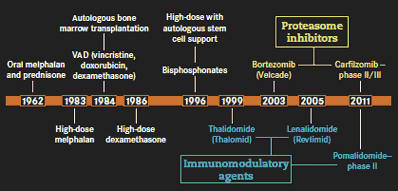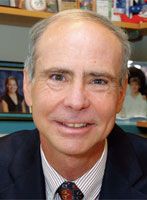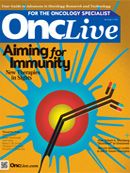Novel Therapies Usher in New Era
Every decade during the past 50 years, treatment for multiple myeloma has taken a leap forward.
Every decade during the past 50 years, treatment for multiple myeloma (MM) has taken a leap forward. Now, novel therapies developed at a relatively rapid pace are poised to deliver a new era of advances that promise to signifi cantly prolong the lives of many patients.
“It’s a new world in multiple myeloma,” leading researcher Kenneth C. Anderson, MD, said in an interview with OncLive. “We’ve had novel therapies that have already transformed the natural history of the disease, but due to advances in genomics on the one hand and novel targeted therapies on the other, the best is yet to come.”
Anderson, a professor at Harvard Medical School and director of the LeBow Institute for Myeloma Therapeutics and the Jerome Lipper Multiple Myeloma Center at the Dana-Farber Cancer Institute in Boston, Massachusetts, was recognized for his contributions to MM research at the 2011 American Society of Clinical Oncology (ASCO) annual meeting in Chicago on June 4. He received the society’s highest honor, the David A. Karnofsky Memorial Award.
“What’s really changed things in our disease is the advent of novel therapies, starting with thalidomide in the late 1990s, which have quite literally transformed the way we think about and treat multiple myeloma,” Anderson said in his ASCO speech.
“We have a new treatment paradigm based on targeting the tumor in the microenvironment, and it has really, for many patients, made myeloma a chronic illness already,” he said in an interview.
Developments in Multiple Myeloma Research

Adapted from Anderson KC. Bench to bedside translation of targeted therapies in multiple myeloma. Presented at 2011 American Society of Clinical Oncology Annual Meeting; June 4, 2011; Chicago, Il.
Anderson said the median survival for MM patients is now 7 years, more than double the rates of the early 1960s, when chemotherapeutic melphalan was introduced.
In May, Anderson joined in unveiling results of a large, phase III trial demonstrating the benefi ts of lenalidomide at the 13th International Myeloma Workshop in Paris, France. The drug, administered orally, nearly doubled the median time-to-progression to 43.6 months for patients with stage I/III MM who took the capsules continuously as maintenance therapy after autologous stem cell transplant, versus 21.5 months for the placebo group.
Questions linger about whether patients face the risk of developing second cancers. Anderson has said the incidence does not appear higher than the rate normally associated with aging, and that the benefi ts outweigh the risk.
Now that novel therapies are producing such notable results, researchers are focusing on combinations that will move patients with MM away from stem cell transplants as a fi rst option for treatment, Brian G.M. Durie, MD, chairman of the International Myeloma Foundation and vice-chair of the Myeloma Committee of the Southwest Oncology Group, said in an interview.
“These new types of drugs have a much more powerful impact on myeloma and are well tolerated and are not traditional chemotherapy,” he said. “… It’s a big, big change.”
Anderson said in his ASCO presentation that promising studies are underway, particularly trials combining bortezomib and lenalidomide. He said the drugs kill myeloma cells by distinct mechanisms and can trigger dual apoptotic signaling. When used upfront in phase I/II trials, the combination demonstrated a nearly 100% response rate, including a >50% complete or near-complete response, Anderson said.
Quick Quotes

Kenneth C. Anderson, MD
On his research focus:
We are trying to develop cocktails of therapies that would be used in the overwhelming majority of patients and will achieve extent and frequency of responses. At the same time, few, if any, patients are being cured, and so we need to understand better both at the time of diagnosis, but especially at the time that myeloma comes back or relapses, what are the characteristics of that myeloma so that we can effectively target in the early, newly diagnosed patients to prevent the drug resistance from developing.
On next steps:
I think on the one hand combinations of multiple drugs, probably 4 or even 5 drugs based on science, will become quickly in order to not only get responses in everybody but to get hopefully complete or near-complete responses in everybody.
We’ll have further research on the maintenance [therapies]. With lenalidomide, it’s a clear major advance, but do we need to have more than one drug for maintenance, or are there other agents that can also be very effective?
Then on the biomarker, what I like to call personalized medicine front, there’s a lot of research using genomics tests to better segment patients with myeloma, better understand who responds or who doesn’t, and why.

Brian G.M. Durie, MD
On research priorities:
I think there are really two ways forward right now. We have these novel agents that have given us important clues about types of treatment that can work better in myeloma. The first thing is that we discovered that these drugs that work as IMiDs [immunomodulatory drugs] and as proteasome inhibitors can really make an important difference. So finally we had targets. We realized that if we tackle these targets, it is a good place to start in shutting down myeloma. And so the one way forward is to refine those targets, and then maybe combine those targets with some other targets.
The second approach is to keep looking for a cure. In other words, we want an approach that can just really wipe out a myeloma, and could that come from some combination of those new drugs? I think everyone is expecting that we need some slightly new idea that would finally come up with that cure.




